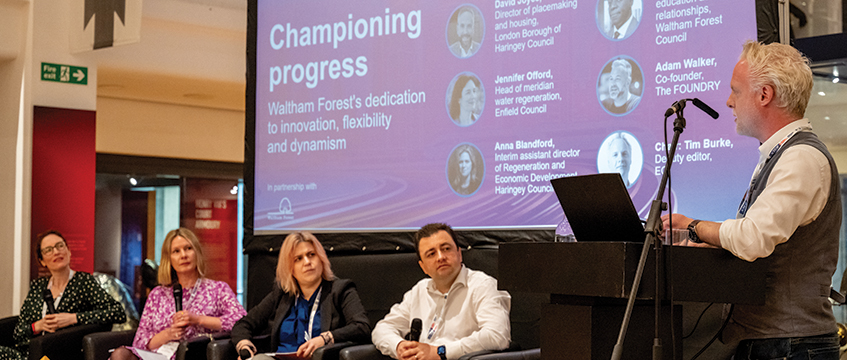When local authorities talk about working across borough boundaries, it can sound easier than it is. At last month’s UKREiiF conference in Leeds, EG brought together leaders from three councils in the Upper Lea Valley in north-east London to talk about just how they make it work.
Across a presentation and panel discussion, the event explored Waltham Forest’s journey to foster innovation and a vibrant community and local economy and the ways in which it has worked with neighbouring Haringey and Enfield councils to take those ideas further than might be possible acting individually.
Waltham Forest was London’s first borough of culture in 2019 – Jonathan Martin, director of inward investment and higher education academic relationships at Waltham Forest Council, said much of the achievement since has been to build on the legacy of that. Now a creative enterprise zone, the borough has built a buzzing local economy around creative industries.
“It’s about enhancing our heritage, and how we can build on our community infrastructure,” he said, highlighting a new university, new Soho Theatre and other fresh developments transforming the borough and showing “the art of the possible, the scale of the opportunity and the potential”.
David Joyce is director of placemaking and housing at Haringey Council, which is now preparing to take on the borough of culture crown in 2027 and is similarly focused on its creative industries with its new Opportunity Haringey programme.
“We were the first creative enterprise zone in London,” Joyce said. “We did not know the industries and potential we had in the borough. We didn’t know the industries on our industrial estate. When you peeled back and realised we had costume designers, businesses supporting the film industry in Enfield – everything is going on there. Now, how do we bring in more cultural anchors?”
Share and share alike
Fay Cannings, senior inward investment manager at Waltham Forest Council, reflected on lessons for the local authority over recent years.
“It’s been an evolutionary journey. One of the fundamental aspects of the success has been the organic, natural approach that happened across the borough. We are well known for our heritage and our culture. Through the borough of culture we saw 50,000 local residents coming to local events and contributing a huge amount to economic activity. We have that strong DNA and it’s been part of the next wave of development as creative businesses move into the borough.”
The boroughs are learning from each other. Anna Blandford, interim assistant director of regeneration and economic development at Haringey Council, said: “We’re all on our own journeys and there are some really great examples for Haringey from other boroughs as we lead up to the borough of culture.
“We learn from what Waltham Forest has done and there are tangible examples of us working together, being able to share funding for businesses and supporting them.”
Jennifer Offord, head of Meridian Water regeneration at Enfield Council, added: “It’s taking the time to meet in person. We had a tri-borough visit recently where we all got together. Then it’s genuine. We really want to know what each other is doing. And so we really need to group together and listen.
“We are comparing notes on how we can be creative and how we can get the social value side alongside getting the developers in.”
Setting the benchmark
What do private-sector players find attractive in these boroughs? Legal & General Investment Management has launched The Foundry in Waltham Forest, a local co-working space. Co-founder Adam Walker said the concept had been mooted pre-pandemic, envisioning how to rethink ground and first-floor space in larger schemes such as build-to-rent.
Adam Burney, senior fund manager at LGIM, also joined the panel to discuss the group’s BTR investments. “Our development in Walthamstow of 500 BTR units is something we are extremely proud of. It was our very first BTR scheme in a venture we set out on in 2014.
“One of the reasons it was such a success was that we were working in partnership with Waltham Forest to bring it forward.
“Working locally with stakeholders is extremely important to us and it is something that, as we have rolled out our BTR venture, we have continued across all local authorities, and [Waltham Forest] really set the benchmark.”
The experts
- Anna Blandford, interim assistant director of regeneration and economic development, Haringey Council
- Adam Burney, senior fund manager, Legal & General Investment Management
- Fay Cannings, senior inward investment manager, Waltham Forest Council
- David Joyce, director of placemaking and housing, Haringey Council
- Jonathan Martin, director of inward investment and higher education academic relationships, Waltham Forest Council
- Jennifer Offord, head of Meridian Water regeneration, Enfield Council
- Adam Walker, co-founder, The Foundry
In partnership with:
Photo © JMA Photography
Send feedback to Tim Burke
Follow Estates Gazette











